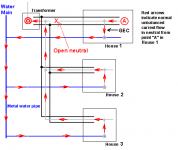EMFExplorer
Member
- Location
- Nashville
- Occupation
- EMF
A number of us have been bringing this issue to light for some time. When a home or other building is connected to city water via copper water supply pipe, and the electrical service is bonded to this pipe, the pipe becomes a secondary neutral current-carrying conductor. Rather than just be present in the temporary event of a fault, it is actually a current-carrying conductor that is operating 24/7/365.
It is my opinion this is very inappropriate and actually violates sections of the NEC. Yet it is also required. I think the code should be updated, and it should be standard practice to electrically isolate the city water network and only use ground rods or other electrodes. When we interconnect all buildings via the water, we create countless paths for circuit current to take that are NOT along the appropriate path - the intended circuit current-carrying conductors - wherein the current should be confined. Using pipes for carrying circuit current should be prohibited.
It is my opinion this is very inappropriate and actually violates sections of the NEC. Yet it is also required. I think the code should be updated, and it should be standard practice to electrically isolate the city water network and only use ground rods or other electrodes. When we interconnect all buildings via the water, we create countless paths for circuit current to take that are NOT along the appropriate path - the intended circuit current-carrying conductors - wherein the current should be confined. Using pipes for carrying circuit current should be prohibited.


